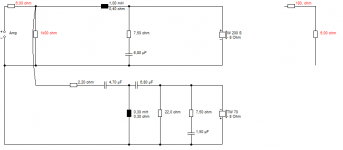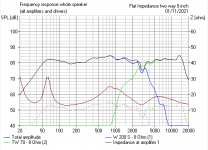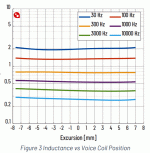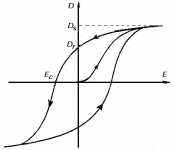Today's Electronics lesson is on Norton-Thevenin Equivalents. Pay attention, class. 🙂
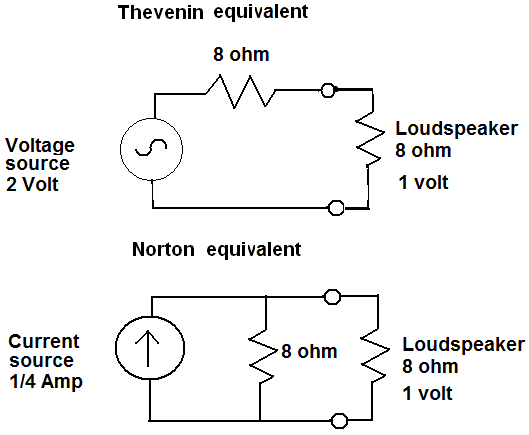
Voltage or Current Source, you get 1 Volt across the load, which might be an impedance corrected loudspeaker. But does it even have to be impedance corrected?
NO. Do the Math, in this case Ohm's Law. If the loudspeaker is a dead short, it gets 1/4 Amp with both amps. If the loudspeaker is an open circuit, it gets 2V with either amp.
Even works with complex loads.
I illustrate this below. I had to approximately simulate a current amp with a 180 ohm resistor, but if you compare the dotted line response with the solid one you see that the response is exactly the same apart from attenuation.
The loudspeaker actually works much flatter with a pure Voltage amp, which is why it looks so ropey here. An amp with a 6 ohm output impedance is moving into the SET Valve category, and we know the tonal problems they have with speaker that have erratic impedance.
I will get back on the Hamlet speaker another time. But noticed it has no bafflestep with a single small bass coil. Must go to bed. So Goodnight.
Voltage or Current Source, you get 1 Volt across the load, which might be an impedance corrected loudspeaker. But does it even have to be impedance corrected?
NO. Do the Math, in this case Ohm's Law. If the loudspeaker is a dead short, it gets 1/4 Amp with both amps. If the loudspeaker is an open circuit, it gets 2V with either amp.
Even works with complex loads.
I illustrate this below. I had to approximately simulate a current amp with a 180 ohm resistor, but if you compare the dotted line response with the solid one you see that the response is exactly the same apart from attenuation.
The loudspeaker actually works much flatter with a pure Voltage amp, which is why it looks so ropey here. An amp with a 6 ohm output impedance is moving into the SET Valve category, and we know the tonal problems they have with speaker that have erratic impedance.
I will get back on the Hamlet speaker another time. But noticed it has no bafflestep with a single small bass coil. Must go to bed. So Goodnight.
Attachments
Hi Steve
The Norton-Thevenin Equivalents are good for what they do, but what happens when the impedance is not stable, the current is not stable, then the 'force' is not stable. They can only give us so much info under static conditions.
My previous post was leading up to something. A driver has to produce multiple frequencies at any time. As frequencies go down, in order for the response to stay flat, lower frequencies have slower acceleration and yet acceleration has to stay constant for sound pressure level to be flat. This relates x4 excursion/octave down.
The force that creates that flat frequency has to have constant acceleration (it's Newton and all that).
Take a look below, this is a Purifi driver, and note how flat the inductance stays with frequency:
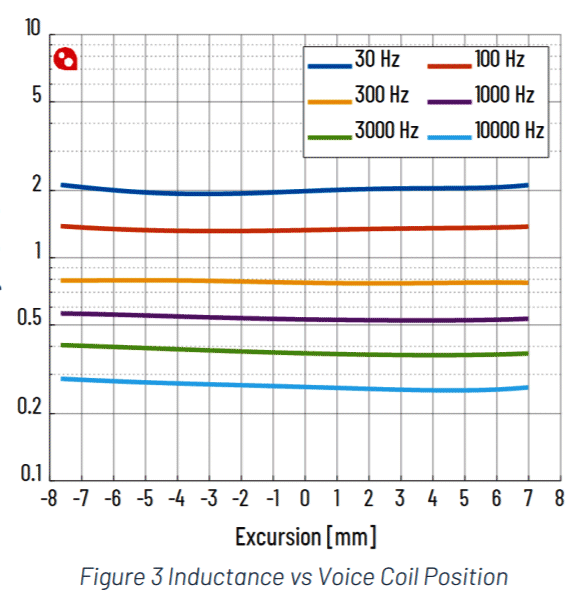
Notice the words "Inductance Versus Coil Position."
This I believe is an amazing achievement in engineering. I am not sure if any driver ever has achieved this before. But impedance is a function of current and not voltage. So this is about what the amplifier sees and responds with current - but with multiple complex set of frequencies, the coil position can be any due to lower frequency displacement and yet be able to produce 1KHz up free of current modulations - modulations that cause fluctuations in force is distortion where 5th and above harmonics show bang up at the most sensitive frequencies.
My single inductor, as large as possible and directly in series with the voice coil, is an attempt at doing this, try to get the inductance as flat as possible and those current modulations at those frequencies will be suppressed.
Now if a low frequency is being produced requiring significant excursion, and a midrange signal where the 5-11th harmonic distortion shows up in the critical area above 1KHz. This driver (with an inductor that does not change with frequency) will suppress those distortions.
What I am saying is that Purifi has achieved is current-drive like benefits and I am trying to do something similar.
So with your Scan-Speak driver example, use a single-as-large-as-possible-inductor and know that the slightly off axis does not have that peak, so don't listen there and maximise the value of the inductor.
This is all about keeping the current of the amplifier as stable as possible and find ways to stabilise the force factor that is directly linked to the current of the amplifier.
An unstable current from the amplifier creates among other things, an unstable force.
If I may quote Lars Risbo of Purifi:
"So if this force factor or BL is not constant with position [of the voice coil], then you are introducing distortion because you no longer having a fixed linear relationship between the current you send in and the force you produce." [] added
A suitable test: A low frequency like 30-50Hz that gives circa 6-10mm excursion (depending on the driver, particularly diameter), and then try various frequencies from around 250Hz and up. Look for the combination that will show up distortions. This is not your usual IMD measurement.
Hope you are taking this in. I admit it has taken me some time and the above is not even the full story, but a good beginning. I am not trying to sound like I have a big head. Maybe tenacity and OCD helps? 😀
The straight-up advantage of current-drive is that the very dynamic impedance of the speaker cannot modulate the current of the amplifier, the current is fixed in place by the amplifier and hence the force factor of the current (current is the force) is more stable. More stable current, less distortion.
Purifi has come up with a driver design that does not and gets those desirable low distortion benefits.
I have some crossover schematics that were given to me confidentially by Esa Merilainen. I have kept that confidence, but if he were to allow me to post them, then you would have another way - based on a 5:1 ratio that we both agreed upon. His designs require very high voltage swings and much lower current. But analysing them, they achieve a similar sort of thing.
So there you are.
Cheers, Joe
The Norton-Thevenin Equivalents are good for what they do, but what happens when the impedance is not stable, the current is not stable, then the 'force' is not stable. They can only give us so much info under static conditions.
My previous post was leading up to something. A driver has to produce multiple frequencies at any time. As frequencies go down, in order for the response to stay flat, lower frequencies have slower acceleration and yet acceleration has to stay constant for sound pressure level to be flat. This relates x4 excursion/octave down.
The force that creates that flat frequency has to have constant acceleration (it's Newton and all that).
Take a look below, this is a Purifi driver, and note how flat the inductance stays with frequency:
Notice the words "Inductance Versus Coil Position."
This I believe is an amazing achievement in engineering. I am not sure if any driver ever has achieved this before. But impedance is a function of current and not voltage. So this is about what the amplifier sees and responds with current - but with multiple complex set of frequencies, the coil position can be any due to lower frequency displacement and yet be able to produce 1KHz up free of current modulations - modulations that cause fluctuations in force is distortion where 5th and above harmonics show bang up at the most sensitive frequencies.
My single inductor, as large as possible and directly in series with the voice coil, is an attempt at doing this, try to get the inductance as flat as possible and those current modulations at those frequencies will be suppressed.
Now if a low frequency is being produced requiring significant excursion, and a midrange signal where the 5-11th harmonic distortion shows up in the critical area above 1KHz. This driver (with an inductor that does not change with frequency) will suppress those distortions.
What I am saying is that Purifi has achieved is current-drive like benefits and I am trying to do something similar.
So with your Scan-Speak driver example, use a single-as-large-as-possible-inductor and know that the slightly off axis does not have that peak, so don't listen there and maximise the value of the inductor.
This is all about keeping the current of the amplifier as stable as possible and find ways to stabilise the force factor that is directly linked to the current of the amplifier.
An unstable current from the amplifier creates among other things, an unstable force.
If I may quote Lars Risbo of Purifi:
"So if this force factor or BL is not constant with position [of the voice coil], then you are introducing distortion because you no longer having a fixed linear relationship between the current you send in and the force you produce." [] added
A suitable test: A low frequency like 30-50Hz that gives circa 6-10mm excursion (depending on the driver, particularly diameter), and then try various frequencies from around 250Hz and up. Look for the combination that will show up distortions. This is not your usual IMD measurement.
Hope you are taking this in. I admit it has taken me some time and the above is not even the full story, but a good beginning. I am not trying to sound like I have a big head. Maybe tenacity and OCD helps? 😀
The straight-up advantage of current-drive is that the very dynamic impedance of the speaker cannot modulate the current of the amplifier, the current is fixed in place by the amplifier and hence the force factor of the current (current is the force) is more stable. More stable current, less distortion.
Purifi has come up with a driver design that does not and gets those desirable low distortion benefits.
I have some crossover schematics that were given to me confidentially by Esa Merilainen. I have kept that confidence, but if he were to allow me to post them, then you would have another way - based on a 5:1 ratio that we both agreed upon. His designs require very high voltage swings and much lower current. But analysing them, they achieve a similar sort of thing.
So there you are.
Cheers, Joe
Attachments
Last edited:
@Joe,
No one is weaponizing anyone. Stop flashing the victim card.
I am tired of hearing people blame others for crap designs or crap work. If a design is crap, the designer bares responsibility- not some faceless unnamed accountant or marketer.
Like I said earlier no accountant has ever come to me and said it’s too expensive despite my involvement in dozens of electronic products and hundreds of semiconductor products.
I agree, but I was the one accused by Bill of weaponising the word 'fix' when I used the word that he had used, but he forgot it. It was a hilarious moment and I felt anything but like a victim. I felt like a victor! He made a fool of himself. lol
Well, at least Purify is trying to make a change although not everybody understands it.
Hans
It's tough going, I think I get about 80% of it. The saturated magnet pole piece, my understanding of magnetics on that level is beyond my paygrade. But how the pieces show symmetry in the pole piece, some of it makes logical sense even if you don't fully understand it. But understanding that current is the force and that force can be destabilised in a number of ways, that's up my alley.
[_] addedPut a 0.1 ohm across the speaker terminals, a 1 Ohm in series. Your 95db driver is now 85. Let's see the back EMF of the speaker influence the output of the amp it would take to drive that. Burn a bunch of power in the 1? That's what the heatsinks on the back of the cabinet are for. Of course I jest, but there's probably an effective passive technique somewhere between brute force and nothing. Right now I'm listening to "nothing" between the speaker terminals and amp, besides the wire.
I have taken my time to properly reply to this suggestion. But imagine you had the ideal voltage source with infinite current capability. Now put a 0.1R resistor in parallel with a typical 8 Ohm speaker. The current will go up eighty-fold, but this is a thought experiment.
Read my above post about the driver causing the force factor to change for the reasons explained. When the amp is typically producing 80 Amp and more, the speaker with a 1A requirement will have a hard time modulating the current of your amp. You now have, in your thought experiment, produced a similar condition to current drive, where the benefit is stable current = stable force.
Now a parallel 8 Ohm resistor will not go that far, but it is down that bit of road. The parallel current in that resistor creating some degree of stable current/force and hopefully should be audible to many. It is not hard to try it.
But is anybody here willing to try it out?
Nope!
So I am asking a dangerous thing, will anybody here try it and report back. I am the one sticking my neck out and there are plenty out there who would love to knock it off!
But at least I am brave. Can't fault me on that? [They hate it when I say that. 🙂]
Cheers, Joe
Good, then just go away. A wolf does not have patience. It just wants to tear.
Not your thread. I ignore your thread for my sanity.
I agree, but I was the one accused by Bill of weaponising the word 'fix' when I used the word that he had used, but he forgot it. It was a hilarious moment and I felt anything but like a victim. I felt like a victor! He made a fool of himself. lol
No you were the fool, and still are as you missed the context and still are missing it. Less typing, more thinking and you just might get it...
Bill, anybody can go back and check. It's a delight to see you trying to change history. Too bad the edit button is no longer available. Wonderful to see you squirming.
Do you really want to keep this up?
So did you like Purifi's fix or not?
Do you really want to keep this up?
So did you like Purifi's fix or not?
Wrong, force acting on the driver depends only on current going through the driver. Current produced by the amplifier has no direct relation to said force since it also contains current to the 0.1R.... Read my above post about the driver causing the force factor to change for the reasons explained. When the amp is typically producing 80 Amp and more, the speaker with a 1A requirement will have a hard time modulating the current of your amp. You now have, in your thought experiment, produced a similar condition to current drive, where the benefit is stable current = stable force...
I am sorry you don't seem to understand how this works. Indeed you are correct in saying what I have repeated over and over again "the driver depends only on the current through the driver."
So we are in heated agreement.
But the example I gave will mean that the ability of the driver to influence and corrupt the current of the amplifier (and the driver here is definitely the culprit) is much less.
Think of it as the fly that cannot move a mountain.
Is that clearer? I hope so.
Others have understood this, I assure you.
So we are in heated agreement.
But the example I gave will mean that the ability of the driver to influence and corrupt the current of the amplifier (and the driver here is definitely the culprit) is much less.
Think of it as the fly that cannot move a mountain.
Is that clearer? I hope so.
Others have understood this, I assure you.
For a given output voltage, a more stable current vs. frequency through the amplifier due to a parallel 0.1R will not result in a more stable current through the driver, hence no relation to any benefit of current drive can be deduced.
Joe, I accept that your technique may really sound better on some amplifier - speaker pairings, but relation of the perceived positive effect to any benefit attributed to current drive is highly doubtful. It could be something else you have not investigated yet.... Others have understood this, I assure you.
Last edited:
. It's a delight to see you trying to change history.
I repeat. Context.
For a given output voltage, a more stable current vs. frequency through the amplifier due to a parallel 0.1R will not result in a more stable current through the driver, hence no relation to any benefit of current drive can be deduced.
Joe, I accept that your technique may really sound better on some amplifier - speaker pairings, but relation of the perceived positive effect to any benefit attributed to current drive is highly doubtful. It could be something else you have not investigated yet.
That's a mixed message reply?
Again I believe you have missed the argument. Please keep in mind we are talking about a thought experiment when we are looking at the current generated by 0.1R linear load that is in parallel with a non-linear load. It is the amplifier that is furnishing the current. Any variation of that current that is caused by "impedance modulation" (and please keep in mind that was coined by somebody other than me) is now much less part of the current of the amplifier.
Yes, the stability of the current is audible!
Please keep in mind that a voltage source relinquishes any control over the current. So any percentage of current is affected, that causes modulations of the force factor of the driver, this causes distortion.
Think of the massive amount of linear current drawn by 0.1R is like a flywheel. It is now that much more difficult for the driver to influence it. But alas, it is not a practicable 'fix' or solution.
Yes, current modulations of the amplifier are what current-drive avoids (because it fixes the current, the load cannot modulate it). We need to suppress those modulations under voltage drive and hear similar sorts of benefits.
I know that you are going from your cursory 'textbook' understanding, but I am sorry if you do not grasp the above. It is not counter to textbook at all.
Cheers, Joe
Last edited:
Bill, you have forgotten the context. Go back again and see what a goose you made of yourself. Sigh...
No, it stays flat with coil position.Take a look below, this is a Purifi driver, and note how flat the inductance stays with frequency:
Do you see what you write ?impedance is a function of current and not voltage.
This is indeed what Purify have achieved.with multiple complex set of frequencies, the coil position can be any due to lower frequency displacement and yet be able to produce 1KHz up free of current modulations
I fail to see how, because it does not change a bit to the the changing induction versus coil position.My single inductor, as large as possible and directly in series with the voice coil, is an attempt at doing this, try to get the inductance as flat as possible and those current modulations at those frequencies will be suppressed.
Why, please show some measurement to support this.Now if a low frequency is being produced requiring significant excursion, and a midrange signal where the 5-11th harmonic distortion shows up in the critical area above 1KHz. This driver (with an inductor that does not change with frequency) will suppress those distortions.
Hans
Probably on most tube gears, not necessarily true for all amplifiers, try high power SS gears designed by Pavel Macura, John Curl or similar.Yes, the stability of the current is audible!
But this statement you made earlier is wrong since stability of current through the driver is not established.... similar condition to current drive, where the benefit is stable current = stable force...
stability of current through the driver is not established.
And never will be. Joe has been peddling this for years now.
Seems he took a stable amplifier output current to mean stable current through the driver which can no longer be true once a parallel equalizing network is in place. Seems funny he so much wants to belong to a current driven crowd considering all the problems associated with it.
I think Joe is saying distorted speaker current negatively affects the amplifier.
Say you have 1A fundamental and 10mA 2nd harmonic currents being drawn from the amplifier by the speaker. Put an 8ohm resistor in parallel and now you have 2A fundamental and 10mA 2nd harmonic. Joe seems to be saying this will sound better.
Say you have 1A fundamental and 10mA 2nd harmonic currents being drawn from the amplifier by the speaker. Put an 8ohm resistor in parallel and now you have 2A fundamental and 10mA 2nd harmonic. Joe seems to be saying this will sound better.
Ever helpful as I am, I hope to move the debate onto the relentless improvement in loudspeakering that we all seek. 🙂
Let's all try and sing from the same songsheet here. Seems to me the issue is Joe Rasmussen's cheaper follow up to his commendable Elsinore speaker, the Hamlet:
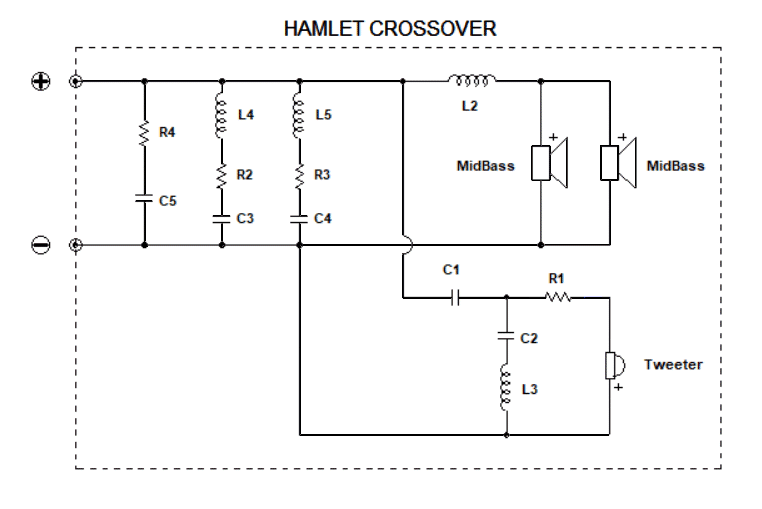
I seriously don't think this will break Ohm's Law, V=IR, as we all know. And a laughably simple basic circuit that even a Child of 10 can analyse. Issues with bafflestep, unless wall-mounted IMO.
I have already debunked any deranged notion that Current drive is much different from Voltage drive:

Linearity is a hugely important factor in decent sound. Non-linearities produce irreversible distortion and loss of information. Voice-coil non-linearities, whether underhung or overhung, are a problem that was addressed about a hundred years ago in Helmholtz Coils (which you can look up) for a linear magnetic field. I have used them in the Physics Lab. Ferrite hysteresis is also well established as a bad thing.
When all other possibilities are exhausted, what is left is what the answer is. I do think Joe is onto something with low-inductance, and possibly high Qms drivers. I also approve of amps getting easy loads. The Devil is in the detail. 😀
Let's all try and sing from the same songsheet here. Seems to me the issue is Joe Rasmussen's cheaper follow up to his commendable Elsinore speaker, the Hamlet:

I seriously don't think this will break Ohm's Law, V=IR, as we all know. And a laughably simple basic circuit that even a Child of 10 can analyse. Issues with bafflestep, unless wall-mounted IMO.
I have already debunked any deranged notion that Current drive is much different from Voltage drive:
Linearity is a hugely important factor in decent sound. Non-linearities produce irreversible distortion and loss of information. Voice-coil non-linearities, whether underhung or overhung, are a problem that was addressed about a hundred years ago in Helmholtz Coils (which you can look up) for a linear magnetic field. I have used them in the Physics Lab. Ferrite hysteresis is also well established as a bad thing.
When all other possibilities are exhausted, what is left is what the answer is. I do think Joe is onto something with low-inductance, and possibly high Qms drivers. I also approve of amps getting easy loads. The Devil is in the detail. 😀
Attachments
I seriously don't think this will break Ohm's Law, V=IR, as we all know. 😀
At what Frequency?
I guess that we all know that
Ohms law is not
V=I*R
But: U=I*Z
Where Z=R+X and Xl=jwL and Xc=1/jwC
I guess that everybody here knows what "w" and "j" are as well.
Stein
hi,
I am not sure I fully follow what the heated dispute is about but please let me throw this in:
Current drive (the amp cnontrols the current in response to the input signal) takes away the disortion coming form dynamic modulaiton of the blocked impedance (change of Re and inductance). This modulation typically comes from position dependent inductance/impedance and hysteresis distoriton (memory effects of the iron causing sudden changes in the inductance/permeability).
However, current drive does not cure the modulation of Bl - here we both have a position dependency and a current dependency. However, if the inductance is independent of the position then the current induced Bl modulation goes away.
The Purifi solution (aka fix) is to flatten Bl(x) using winding profile gaps and make Bl independet of the current by keeping the inductance position invariant. The hysteresis distortion is reduced by the special topology of the motor and use of loads of shorting rings.
The combined motor can be voltage driven and achieve the same advantagess as current drive plus removing the current and position dependent Bl distortion. In addition, we still have the electrical damping around fs. What is not solved is the thermal modulation of Re and the hysteresis distoriton is not completely removed but is taken very far down (-80dB).
Cheers,
Lars @PURIFI
I am not sure I fully follow what the heated dispute is about but please let me throw this in:
Current drive (the amp cnontrols the current in response to the input signal) takes away the disortion coming form dynamic modulaiton of the blocked impedance (change of Re and inductance). This modulation typically comes from position dependent inductance/impedance and hysteresis distoriton (memory effects of the iron causing sudden changes in the inductance/permeability).
However, current drive does not cure the modulation of Bl - here we both have a position dependency and a current dependency. However, if the inductance is independent of the position then the current induced Bl modulation goes away.
The Purifi solution (aka fix) is to flatten Bl(x) using winding profile gaps and make Bl independet of the current by keeping the inductance position invariant. The hysteresis distortion is reduced by the special topology of the motor and use of loads of shorting rings.
The combined motor can be voltage driven and achieve the same advantagess as current drive plus removing the current and position dependent Bl distortion. In addition, we still have the electrical damping around fs. What is not solved is the thermal modulation of Re and the hysteresis distoriton is not completely removed but is taken very far down (-80dB).
Cheers,
Lars @PURIFI
- Home
- Member Areas
- The Lounge
- The Black Hole......
